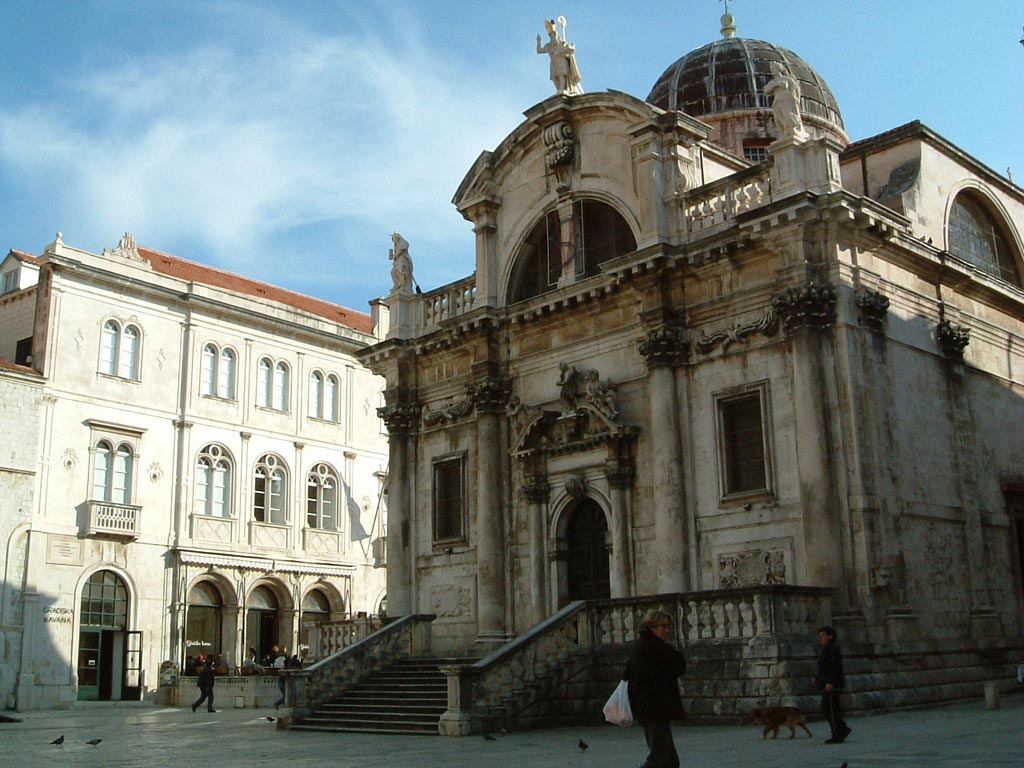You are here: ![]() > Trogir
> THINGS TO DO
> Towns
> Dubrovnik
> Trogir
> THINGS TO DO
> Towns
> Dubrovnik
Dubrovnik
GEOGRAPHICAL POSITION
Dubrovnik is situated in the very south of the Eastern Adriatic coast, between sea and mountains, encircled by stone walls, a perfect work of beauty, harmony and nobleness. Lying below the rocky mountain range of the Dinara and some smaller mountains. Its borders run from Neum in the west to Sutorina and Ponta Ostra in the east. The border-line of this area goes along the mountain tops on the side of Herzegovina and partly on the side of Montenegro. The city is protected against the north wind (bura) by Mount Srd, and against the blows of the south wind (jugo) by the islet of Lokrum. Elaphiti Islands are covered with characteristic Mediterranean evergreen vegetation and attract large numbers of tourists during the summer tourist season due to their beaches and pristine scenery.

HISTORICAL MONUMENTS
The centuries have passed and left us this City as inheritance, while it lasts patiently, proud of ascents, gloomy beacause of declines, but always upright. The history of this City is very long, in 9th century it was under Byznatium rule and in 14th century under Venetian. While Dubrovnik was under Venetion rule, it was called Dubrovnik Republic. All private interests were subordinated to the benefit of the state. Dubrovnik, during its thousand-year history never made agressive war, but maintained freedom and peace by skilful and wise diplomacy.
For some people Dubrovnik is the city of art, for some others the city of noble architecture, for some the city of history, a city adorned by poets and painters, but Dubrovnik is all that together.
The south part of mighty Dubrovnik walls was built on steep cliffs which descend to the sea. For Bokar, built in the 15th century to defend the Pile Gate, is of an exceptional beauty. The walls run an uninterrupted course of approximately 1,940 metres in length, encircling most of the old city, and reach a maximum height of about 25 metres. Its symbol of Dubrovnik and part of UNESCO world heritage. The Pile Gate is the west entrance to the City built from the 14th to the 16th centuries.

In his honour the people of Dubrovnik built a church where there once stood a Romanesque church. St. Vlaho church (St. Blaise) was built in 18th century in the baroque style and the interior of the church is richly decorated. On the main altar there is a statue of St. Vlaho holding a model of Dubrovnik before the earthquake; it is interesting that the statue survived undamaged while the church was destroyed. According to word of mouth legend, St. Vlaho saved the people of Dubrovnik in the 10th century from Venetian attacks.

Stradun (Placa) is the main street in Dubrovnik with numerous steeps. The limestone-paved pedestrian street runs some 300 metres through the Old Town,
the historic part of the city surrounded by the Walls of Dubrovnik.
The big stone column decorated by the figure of the medieval knight Orlando was built in the 15th century by the sculptor Bonino from Milan. The length of the elbow from his right hand was taken as a measure of length, so called Dubrovnik elbow. The legend says, "Orlando can show you weather". If is under his suite wet, it will be rain, but if is not, it will be sunny.
The Rector's palace was the centre of government in the old Dubrovnik Republic. It was built in 15th century in gothic style by the famous Neapolitan architect Onofrio di Giordano de la Cava.
The Sponza Palace was the seat of a number of state offices. The palace also housed the mint, the bank, the treasury, and the armoury. Sponza palace has a unique role during the special opening ceremony of the Dubrovnik Summer Festival. Actors inpersonating the Rector and the members of the Council Minor sit on the upper porch of the Sponza palace and greet the actors that have come to the City to entertain and amuse the public with their music shows and theatre plays.
LEISURE TIME
Dubrovnik is town of fun and pleasure where you can taste their traditional food and known the customs.
Eating out in dubrovnik is a delight, especially during the summer , when nearly all restaurants have outside tables, either on a terrace, a pavement, or right beside the sea. Another thing that visitors will notice is that while some establishments are called restaurants, others are known as konobas. Prevalent of Dubrovnik's menus is shellfish (skoljke), risotto (rizot), lobster (jastog), oysters (ostrige)...
Dubrovnik is not a place for serious shoppers, but there is a number of small shops and galleries sell work by contemporary Croatian artists, usually at reasonable prices.
If your idea of nightlife is sitting in a pleasant cafe under the stars with drink in front of you and music in the background, or listening to a classical recital in an ancient building, Dubrovnik will suit you well. If your taste veers more towards clubs and discos, you may be in wrong in the wrong place, but there are a few places with night-time action like Lazareti.
There are two major festivals in Dubrovnik: the celebrations for St. Blaise's day on 2-3 February, and the Summer Libertas Festival in July and August.






 Join us for free on Trogir walking tour
Join us for free on Trogir walking tour
 10% discount on day excursions from our offer
10% discount on day excursions from our offer
 15% discount on rental service
15% discount on rental service














